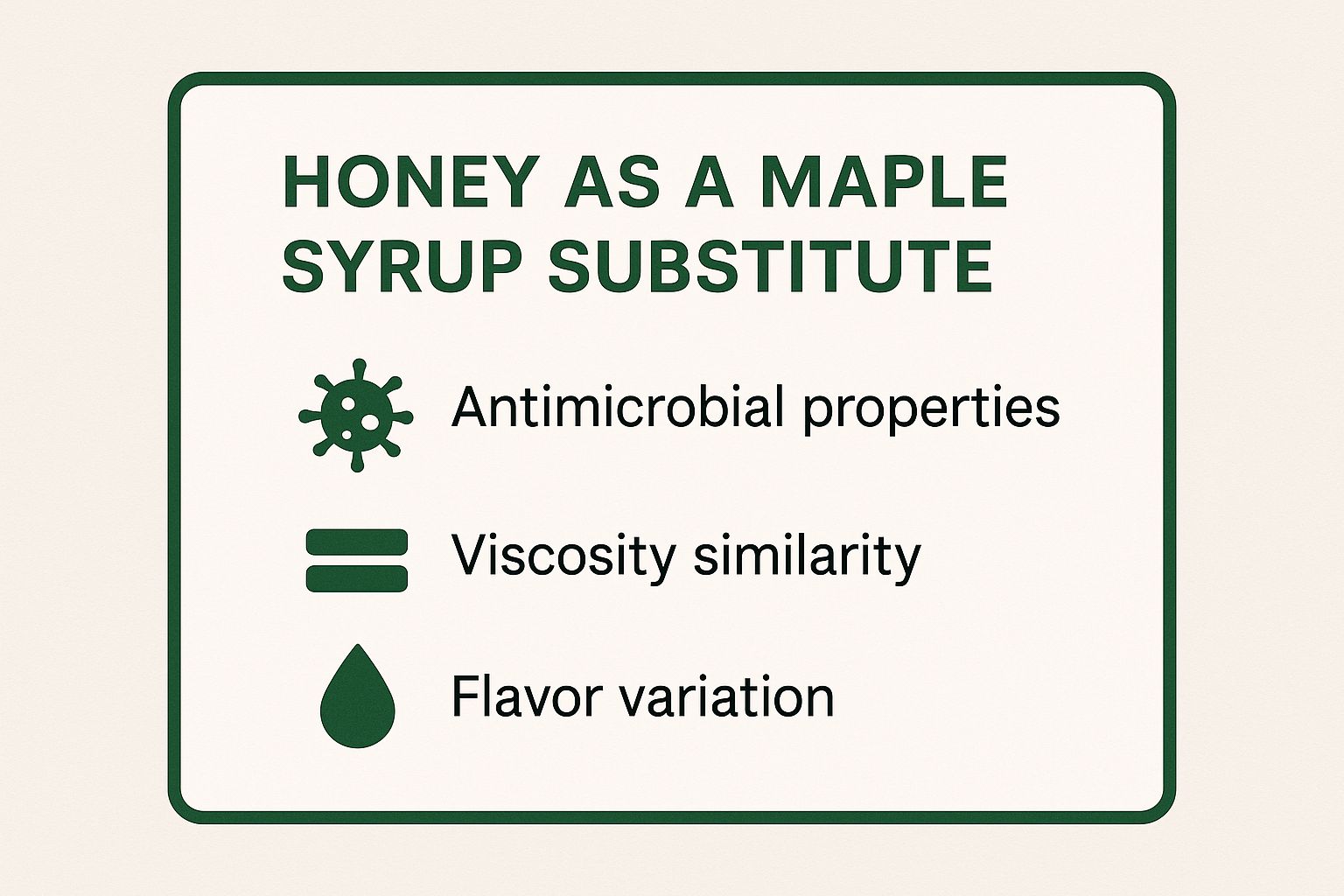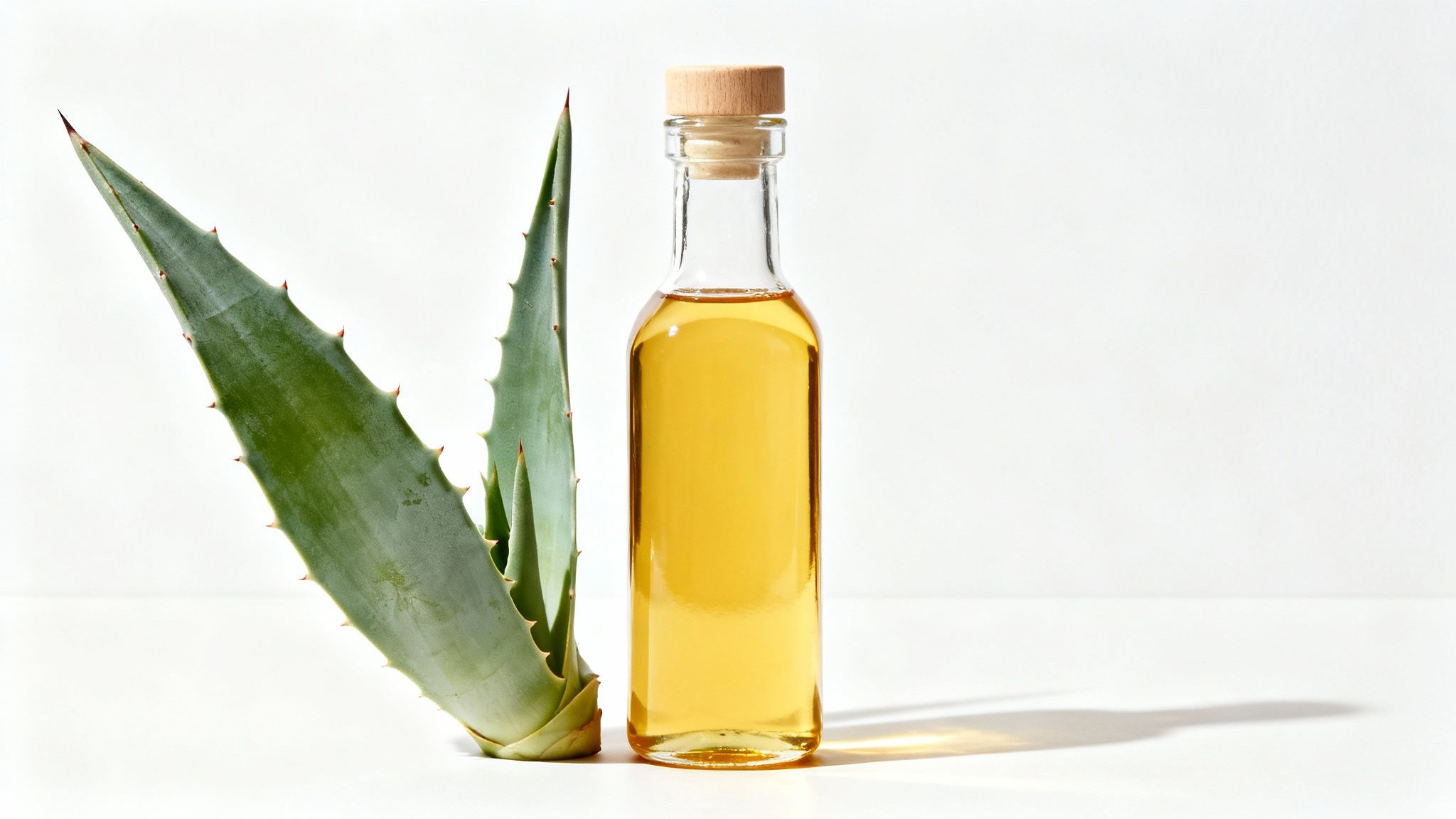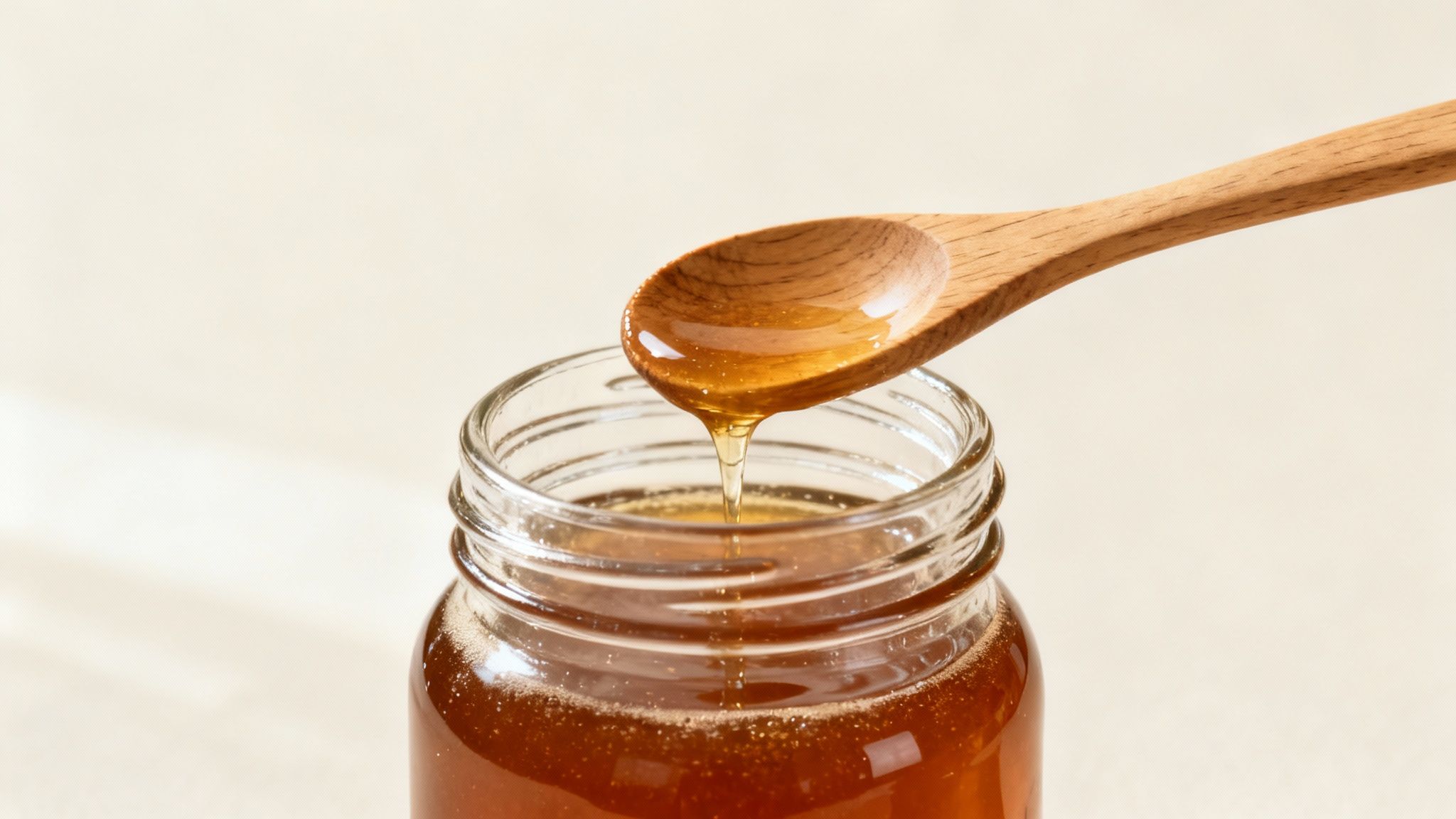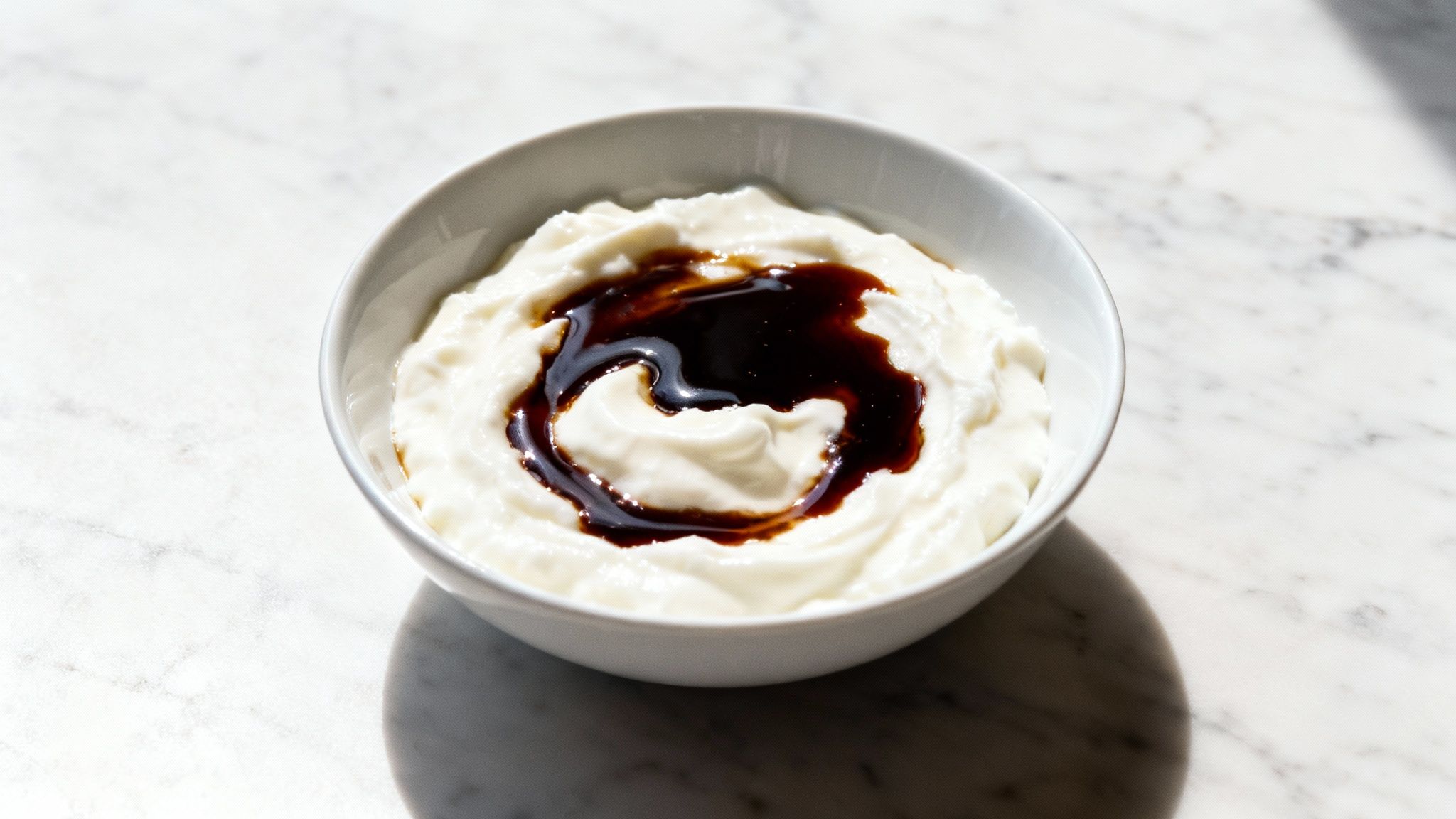8 Best Maple Syrup Substitute Options for 2025
That moment of dread is all too familiar: you’re ready for a perfect stack of pancakes, a complex baking recipe, or a savory glaze, and the maple syrup bottle is empty. The frustration of running out of a key ingredient is universal; for example, you might frequently need to find suitable baking substitutes for buttermilk for other recipes. But before you rush to the store, know that a perfect maple syrup substitute is likely already in your kitchen.
While maple syrup offers a unique, complex flavor, its absence doesn’t mean your dish is doomed. In fact, it presents an opportunity to explore new flavor profiles and textures. From the floral notes of honey to the rich caramel of date syrup, the right substitute can elevate your recipe in unexpected ways. This guide breaks down the top 8 alternatives, providing precise substitution ratios, flavor comparisons, and expert tips to ensure your culinary creations are a success. We’ll cover everything you need to know to confidently swap, bake, and drizzle your way to deliciousness.
1. Honey
As one of the most natural and widely available sweeteners, honey is an excellent maple syrup substitute. Produced by bees from the nectar of flowers, it shares a similar viscosity and sweetness level, making it a seamless replacement in many contexts. Its flavor, however, is distinctly floral and can vary significantly depending on its floral source, from light and mild clover honey to dark and robust buckwheat honey.
This versatility makes it perfect for a wide range of uses. Imagine drizzling warm honey over a stack of pancakes, using it to sweeten a Greek yogurt parfait, or incorporating it into a glaze for ham. It’s also a common binder and sweetener in granola and energy bar recipes.
Key Considerations for Using Honey
When substituting honey for maple syrup, keep these tips in mind for the best results:
- Substitution Ratio: Use a 1:1 ratio. If your recipe calls for one cup of maple syrup, use one cup of honey.
- Baking Adjustments: Honey caramelizes and browns faster than maple syrup due to its fructose content. When baking, reduce your oven temperature by about 25°F (15°C) to prevent premature browning.
- Flavor Matching: For a flavor profile closer to maple syrup, opt for lighter, milder honey varieties like clover, acacia, or orange blossom.
- Moisture Content: Honey has a slightly higher moisture content. For precision in baking, you can reduce other liquids in the recipe by about one tablespoon for every cup of honey used.
The following summary box highlights the key characteristics of honey as a substitute.

This quick reference underscores honey’s similar thickness and diverse flavor profiles, making it a reliable and adaptable maple syrup substitute for both cooking and baking applications.
2. Agave Nectar (Agave Syrup)
Extracted from the same plant used to make tequila, agave nectar is a popular plant-based maple syrup substitute. It has a thinner consistency than maple syrup but a significantly sweeter taste. Its flavor is generally neutral and clean, which allows it to sweeten dishes without overpowering other ingredients, though darker varieties offer a more complex, caramel-like note.

This makes it an excellent choice for a variety of culinary applications. It dissolves easily in both hot and cold liquids, making it perfect for sweetening iced tea, smoothies, or cocktails like margaritas. In vegan baking, it’s a common replacement for honey or maple syrup in raw desserts and energy balls, and it adds a subtle sweetness to BBQ sauces and Southwestern-style marinades.
Key Considerations for Using Agave Nectar
When substituting agave nectar for maple syrup, keep these tips in mind for the best results:
- Substitution Ratio: Use about 2/3 cup of agave for every 1 cup of maple syrup called for in a recipe, as agave is considerably sweeter.
- Baking Adjustments: Like honey, agave nectar browns faster than maple syrup. Reduce your oven temperature by approximately 25°F (15°C) to prevent recipes from over-browning.
- Flavor Matching: For a flavor profile that more closely mimics maple syrup, choose a darker, amber-colored agave nectar which has a more robust taste.
- Moisture Content: Agave has a high moisture content. To maintain the right consistency in baked goods, you may need to reduce other liquids in the recipe by about 1/4 cup for every cup of agave used.
3. Brown Sugar Syrup
As a highly accessible and budget-friendly option, brown sugar syrup is an excellent maple syrup substitute you can easily make at home. Created by simply dissolving brown sugar in water and simmering it, this syrup develops a rich, caramel-like flavor with molasses undertones that mimics the depth of real maple syrup. Its simplicity and low cost have made it a staple in frugal kitchens and a go-to for anyone in a pinch.

This homemade syrup is incredibly versatile. It’s a perfect topping for pancakes, waffles, or French toast when the maple syrup bottle is empty. Beyond breakfast, it works wonderfully as a sweetener in oatmeal, a glaze for roasted carrots, or as a flavorful simple syrup in coffee and cocktails. Its warm, comforting taste also makes it a fantastic addition to various family-friendly recipes, complementing many healthy family dinner ideas.
Key Considerations for Using Brown Sugar Syrup
When substituting brown sugar syrup for maple syrup, keep these tips in mind for the best results:
- Substitution Ratio: Use a 1:1 ratio. If a recipe calls for one cup of maple syrup, use one cup of brown sugar syrup.
- Flavor Enhancement: To achieve a more authentic maple flavor, add a small splash of maple extract to your homemade syrup after it cools.
- Consistency Control: You can easily adjust the thickness. For a thinner syrup, use less simmering time; for a thicker, more concentrated syrup, simmer it longer. A typical starting point is a 1:1 ratio of brown sugar to water.
- Choosing Your Sugar: Using dark brown sugar will yield a deeper, more robust molasses flavor that is closer to dark grades of maple syrup, while light brown sugar creates a milder, more caramel-like taste.
This video provides a simple visual guide to making your own brown sugar syrup at home.
This easy-to-make substitute offers a reliable and customizable alternative, ensuring you always have a delicious syrup on hand for any culinary need.
4. Corn Syrup (Light or Dark)
As a highly functional and shelf-stable sweetener, corn syrup is a practical maple syrup substitute, particularly in baking and candy-making. Derived from corn starch, it provides sweetness and moisture without crystallizing, a quality that makes it invaluable in confectionery. While light corn syrup is neutral in flavor, dark corn syrup contains molasses, giving it a richer taste and color that more closely mimics maple syrup.
Corn syrup’s utility shines in recipes where texture is key. It is the traditional backbone of pecan pie, ensures a smooth texture in homemade ice cream, and creates the perfect chewiness in caramel candies. For a quick pancake topping, dark corn syrup can be warmed with butter and a splash of vanilla to create a simple, effective syrup when maple is unavailable. It’s also a key ingredient in many commercial pancake syrups.
Key Considerations for Using Corn Syrup
When substituting corn syrup for maple syrup, keep these tips in mind for the best results:
- Substitution Ratio: Use a 1:1 ratio. Replace one cup of maple syrup with one cup of corn syrup.
- Flavor and Color: Opt for dark corn syrup for a deeper color and a more robust flavor profile. For an authentic maple taste, add ¼ to ½ teaspoon of maple extract per cup of corn syrup used.
- Sweetness Level: Corn syrup can be slightly sweeter than maple syrup. You may want to reduce the amount by a couple of tablespoons per cup if you prefer a less sweet outcome.
- Best Applications: It works best in baked goods, glazes, and candies where the maple flavor is not the primary focus. Its ability to prevent sugar crystallization makes it a superior choice for certain desserts. Using it wisely is also a great way to prevent pantry staples from going unused, a key aspect of effective food waste reduction strategies.
5. Molasses
As a thick, dark syrup resulting from sugar processing, molasses is a bold and distinctive maple syrup substitute. Its flavor is robust, complex, and slightly bittersweet, varying from the milder taste of light molasses to the intense, mineral-rich notes of blackstrap. While it lacks the delicate, woodsy flavor of maple, its assertive character makes it an excellent replacement in recipes that can handle a stronger profile.
Molasses brings a unique depth to many classic dishes. It is the essential ingredient in gingerbread and chewy molasses cookies, and it provides the traditional sweet and smoky flavor in Boston baked beans. You can also find it adding complexity to barbecue sauces and marinades or giving a rich, dark color to pumpernickel bread.
Key Considerations for Using Molasses
When substituting molasses for maple syrup, keep these tips in mind for the best results:
- Substitution Ratio: Use a 3/4:1 ratio. For every cup of maple syrup, use three-quarters of a cup of molasses to avoid overpowering your dish.
- Flavor Matching: For a taste that is closer to maple syrup, choose light molasses. Dark or blackstrap molasses should be reserved for recipes where a very strong, spiced flavor is desired.
- Sweetness Adjustment: Molasses, especially blackstrap, is less sweet than maple syrup. You may need to add a tablespoon or two of another sweetener, like sugar or corn syrup, to balance the flavor.
- Baking Adjustments: The dark color of molasses can cause baked goods to brown more quickly. Monitor your baking time closely and consider a slight reduction in oven temperature if needed.
6. Golden Syrup (Light Treacle)
As a beloved staple in British baking, golden syrup is a fantastic maple syrup substitute. This thick, amber-colored inverted sugar syrup has a buttery, caramel-like flavor and a smooth consistency very similar to maple syrup. Also known as light treacle, it provides a sophisticated sweetness that enhances recipes without introducing a strong maple flavor.
Its rich yet mellow taste makes it incredibly versatile. Golden syrup is the key ingredient in classic British treacle tarts and flapjacks, and it adds essential moisture and chewiness to ANZAC biscuits and sticky toffee pudding. It also works beautifully in glazes for roasted vegetables or as a sweetener in tea and coffee, offering a unique depth of flavor.
Key Considerations for Using Golden Syrup
When substituting golden syrup for maple syrup, keep these tips in mind for the best results:
- Substitution Ratio: Use a straightforward 1:1 ratio. If your recipe calls for one cup of maple syrup, use one cup of golden syrup.
- Pouring Tip: Golden syrup is very thick. To make it easier to pour and measure accurately, gently warm the jar or tin in a bowl of hot water for a few minutes.
- Flavor Profile: Its flavor is buttery and rich, lacking the distinct woodsy notes of maple. This makes it an excellent neutral sweet base in baking, particularly in oat-based recipes like granola or cookies.
- Pancake Syrup Hack: For a quick pancake topping, warm the golden syrup with a small amount of butter and a few drops of maple extract to mimic the classic breakfast experience.
7. Date Syrup
Date syrup, a staple in Middle Eastern cuisine, is a fantastic maple syrup substitute for those seeking a natural and nutrient-rich option. It’s made by cooking down and concentrating dates into a thick, dark liquid. The result is a uniquely complex sweetener with rich, caramel-like notes that adds significant depth of flavor to any dish it accompanies.

Its robust flavor profile makes it a versatile ingredient. It can be drizzled over oatmeal and smoothie bowls, used in paleo-friendly baking recipes, or mixed with tahini for a traditional spread. It also works beautifully in savory applications, adding a complex sweetness to marinades and salad dressings where its caramel undertones can truly shine.
Key Considerations for Using Date Syrup
When substituting date syrup for maple syrup, keep these tips in mind for the best results:
- Substitution Ratio: Use 2/3 to 3/4 cup of date syrup for every cup of maple syrup, as its flavor is more concentrated.
- Baking Adjustments: Date syrup is very thick. You may need to add a little extra liquid to your recipe to maintain the correct consistency. Warming it slightly also makes it easier to pour and mix.
- Flavor Matching: This substitute is best in recipes where its distinct caramel-date flavor will be a welcome addition, such as spiced baked goods, granola, or barbecue sauces.
- Balancing Sweetness: Its intense flavor can be balanced by combining it with another, milder sweetener if you find it overpowering on its own.
8. Coconut Nectar (Coconut Syrup)
Sourced from the sap of coconut palm blossoms, coconut nectar is a fantastic natural maple syrup substitute. The sap is gently heated to evaporate moisture, resulting in a syrup with a mild, caramel-like sweetness that is less overpowering than many other sweeteners. Its popularity has soared within health-conscious communities due to its lower glycemic index and rich mineral content, making it a functional and flavorful alternative.
This versatile syrup shines in recipes where its subtle flavor can complement other ingredients. It is an excellent choice for sweetening paleo pancakes or waffles, blending into smoothies and coffee drinks, or acting as a binder in no-bake energy balls. Its unique taste also lends itself well to Asian-inspired marinades and glazes, adding a layer of complexity without overwhelming the dish.
Key Considerations for Using Coconut Nectar
When substituting coconut nectar for maple syrup, keep these tips in mind for the best results:
- Substitution Ratio: Use a 1:1 ratio. If your recipe calls for one cup of maple syrup, use one cup of coconut nectar.
- Flavor Profile: The flavor is mildly sweet and caramel-like. To mimic maple syrup more closely, consider adding a drop of maple or vanilla extract.
- Consistency: Coconut nectar can sometimes be thinner than maple syrup. If a thicker consistency is needed for a topping, you can gently reduce it on the stovetop over low heat.
- Nutritional Focus: This substitute is ideal for recipes where nutritional benefits are a priority. For those interested in sourcing high-quality ingredients, exploring options at local markets can be a great start. Learn more about seasonal sourcing at The Culinary Collective ATL.
Maple Syrup Substitute Comparison Table
| Substitute | Implementation Complexity 🔄 | Resource Requirements ⚡ | Expected Outcomes 📊 | Ideal Use Cases 💡 | Key Advantages ⭐ |
|---|---|---|---|---|---|
| Honey | Low – direct 1:1 swap, slight temp adjustment | Readily available, low-cost, no refrigeration | Floral sweetness, similar viscosity, crystallizes but reversible | Baking, cooking, topping | Natural, antimicrobial, antioxidants |
| Agave Nectar | Low – adjust quantity due to higher sweetness | Vegan-friendly, moderately priced, shelf-stable | Sweeter, thinner consistency, dissolves in cold liquids | Vegan cooking, cold drinks, baking | Low glycemic index, neutral flavor |
| Brown Sugar Syrup | Very low – homemade with 2 ingredients | Pantry staples, very inexpensive | Sweet with molasses notes, customizable thickness | Budget cooking, emergency substitute | Very affordable, quick, customizable |
| Corn Syrup (Light/Dark) | Low – direct swap with flavor adjustment | Extremely affordable, widely available | Thick, very sweet, prevents crystallization | Baking, candy-making, recipes not requiring maple flavor | Prevents crystallization, long shelf life |
| Molasses | Medium – partial substitution, flavor balancing needed | Affordable, commonly available | Strong, bitter-sweet, less sweet than maple | Spiced baked goods, recipes tolerating strong flavors | High mineral content, rich flavor complexity |
| Golden Syrup | Low – direct 1:1 swap, warming recommended | Less common in N. America, moderate cost | Buttery caramel sweetness, smooth consistency | British/Commonwealth baking, moist baked goods | Prevents crystallization, tender texture |
| Date Syrup | Medium – adjust amount, warming for mixing | More expensive, less common in standard stores | Rich caramel-date flavor, thick consistency | Middle Eastern, paleo, health-conscious recipes | Nutrient-dense, antioxidants, complex flavor |
| Coconut Nectar | Low – direct 1:1 swap, slight reduction for thickness | Expensive, limited availability | Mild caramel flavor, low glycemic index | Paleo, diabetic-friendly, raw/no-bake recipes | Minerals, prebiotics, sustainable harvesting |
Choosing Your Perfect Sweetener Swap
While nothing can perfectly replicate the unique, woodsy flavor profile of pure maple syrup, the pantry is full of powerful alternatives. We’ve explored a diverse lineup of eight sweeteners, from the floral notes of honey and the neutral sweetness of agave to the deep, robust character of molasses. Finding the right maple syrup substitute isn’t about finding a perfect clone; it’s about making an intentional choice that complements your dish.
The key takeaway is to match the substitute to the culinary task.
- For a simple pancake topping, a homemade brown sugar syrup or golden syrup provides that classic warm sweetness and pourable consistency.
- When baking, consider how the substitute’s flavor will interact with other ingredients. Date syrup can add fruity depth to muffins, while agave nectar’s clean taste won’t overpower delicate cakes.
- In savory applications like glazes and marinades, dark corn syrup or molasses can introduce a rich, caramelized complexity that enhances the entire dish.
Ultimately, your confidence in the kitchen grows when you understand not just what to substitute, but why. This knowledge transforms a potential recipe roadblock into a moment of creative opportunity. For those looking to apply these principles beyond home cooking and delve deeper into how natural sweeteners are used in prepared foods, exploring snack bars without added sugar can offer valuable insights into balancing flavor and nutrition. By embracing this flexible approach, you empower yourself to create delicious, successful meals, no matter what your pantry holds.
Ready to see how a professional brings these culinary concepts to life? The chefs at Culinary Collective Atl specialize in creating bespoke menus, masterfully adapting recipes to suit your dietary needs and taste preferences. Whether you’re planning a private dinner or a week of gourmet meals, let us handle the details so you can savor every moment.





